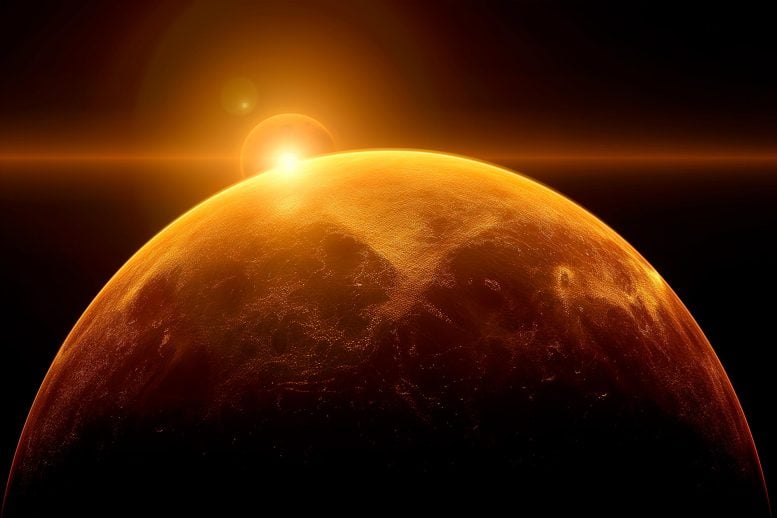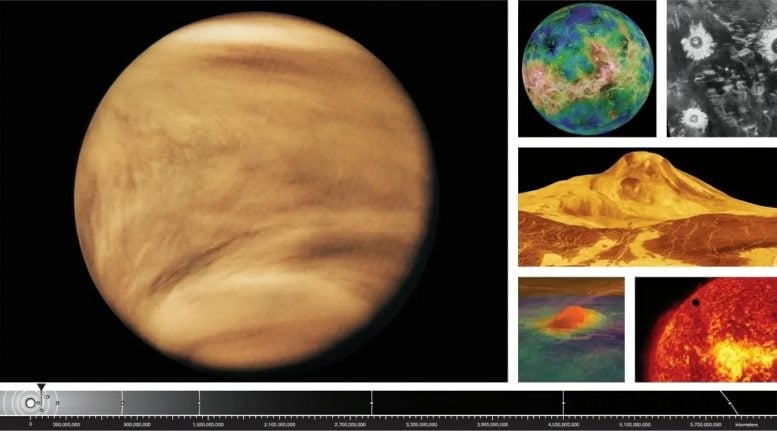
A new article suggests that studying Venus, even though it can't support life, is important for understanding the potential for life on other planets and predicting Earth’s future. It compares Earth and Venus, emphasizes the importance of understanding Venus’s atmosphere and geology, and discusses upcoming NASA missions. The research stresses the need to use Venus as a model for making accurate assumptions about life on distant planets and predicting Earth’s long-term fate. Credit: SciTechDaily.com
Venus is similar to Earth but cannot support life.
Despite its extremely hot surface, erupting volcanoes, and sulfuric acid clouds, Venus, which is not suitable for living beings, provides important lessons about the possibility of life on other planets, according to a new paper.
“We usually think of Earth as the ideal place for life, but if we only focus on this planet, we don't know its boundaries and limitations,” said UC Riverside astrophysicist and lead author of the paper Stephen Kane. “Venus helps us understand that.”
The paper, published in the journal Nature Astronomy, compiles much of what is known about Earth and Venus. It also presents Venus as a reference point for scientists to better comprehend the conditions that prevent life on planets orbiting other stars.
Despite having an atmosphere that would crush a human instantly, Earth and Venus share some similarities. They have similar mass and radius. Given their proximity, it's natural to question why Earth turned out so differently.
Theories about Venus’s Formation
Many scientists believe that the amount of energy Venus receives from the sun, known as insolation flux, caused a runaway greenhouse effect that devastated the planet.
“If you consider the solar energy received by Earth as 100%, Venus gets 191%. Many people believe this is why Venus turned out differently,” Kane said. “But wait. Venus lacks a moon, which is responsible for phenomena like ocean tides on Earth and has affected the amount of water here.”

This illustration showcases images of Venus from the Pioneer Venus, Magellan, TRACE, and Venus Express missions. Credit: NASA
Beyond the known differences, additional NASA missions to Venus would help resolve some uncertainties. Scientists are unaware of the size of its core, how it acquired its current, relatively slow rotation, how its magnetic field evolved over time, or details about the chemistry of the lower atmosphere.
“Venus does not have a detectable magnetic field, which could be related to the size of its core,” Kane said. “The core size also provides clues about how a planet releases internal heat. Earth's mantle distributes heat from its core, but we do not understand the internal processes of Venus.”
The Role of Volcanism and Atmosphere
A terrestrial planet’s interior also affects its atmosphere. This is the case on Earth, where volcanic outgassing has largely shaped our atmosphere.
NASA has twin missions planned for Venus in the late 2020s, and Kane is helping with them. both The DAVINCI mission will explore the acidic atmosphere to measure noble gases and other chemical elements.
“DAVINCI will measure the atmosphere from top to bottom. This will help us create new climate models and predict similar atmospheres on other planets, including Earth, as we continue to increase CO2 levels,” Kane said.
The VERITAS mission, led by NASA’s Jet Propulsion Laboratory, won’t land on the surface but will enable scientists to create detailed 3D maps, revealing if the planet has active plate tectonics or volcanoes.
“Currently, our maps of the planet are very incomplete. It’s very different to understand how active the surface is, versus how it may have changed through time. We need both kinds of information,” Kane said.
Implications for Exoplanet Research and Earth’s Future
The paper argues for missions to Venus for two main reasons. One reason is to use Venus to confirm conclusions about life on distant planets with better data.
“The challenging aspect of the search for life elsewhere in the universe is that we’re never going to have direct data for an exoplanet. We aren’t able to go there, land, or take direct measurements,” Kane said.
“If we believe another planet has surface life, we might never find out if we’re incorrect, and we’d be imagining a planet with life that doesn’t have any. We can only get it right by truly understanding Earth-size planets we can visit, and Venus provides that opportunity.”
Another reason to study Venus is to gain insight into what Earth’s future could resemble.
“One of the main reasons to study Venus is due to our duty as caretakers of this planet, to safeguard its future. I hope that by studying the processes that shaped present-day Venus, especially if Venus had a kinder past that’s now ruined, there are lessons there for us. It could happen to us. It’s a matter of how and when,” Kane said.
Reference: “Venus as an anchor point for planetary habitability” by Stephen R. Kane, and Paul K. Byrne, 22 April 2024, Nature Astronomy.
DOI: 10.1038/s41550-024-02228-5



